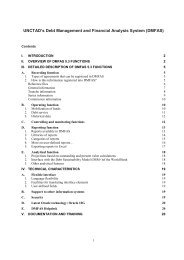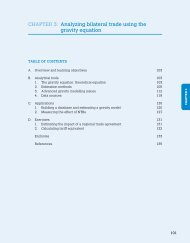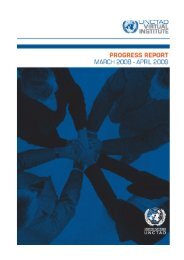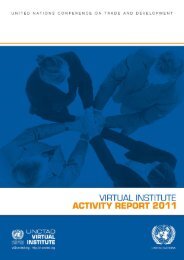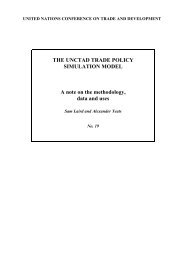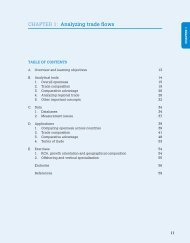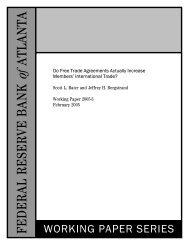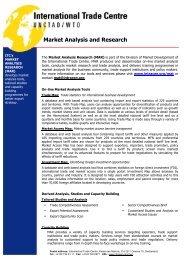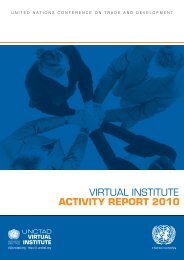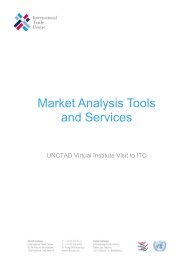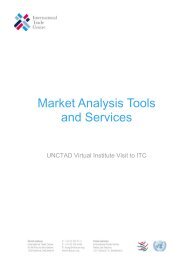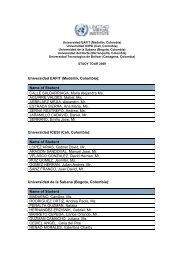Investment Policy Review - Rwanda - UNCTAD Virtual Institute
Investment Policy Review - Rwanda - UNCTAD Virtual Institute
Investment Policy Review - Rwanda - UNCTAD Virtual Institute
You also want an ePaper? Increase the reach of your titles
YUMPU automatically turns print PDFs into web optimized ePapers that Google loves.
<strong>Investment</strong> <strong>Policy</strong> <strong>Review</strong> of <strong>Rwanda</strong><br />
The need for a well-defined and realistic assessment of the potential contribution of FDI still remains.<br />
Beyond general expectations and considerations, and some more detailed sectoral policies, <strong>Rwanda</strong> lacks<br />
a strategy that:<br />
•<br />
•<br />
Has a clear conception of the prospects, including limitations therein, for attracting FDI;<br />
Utilizes FDI to help overcome development constraints by contributing capital, entrepreneurship,<br />
skills, know-how and technology.<br />
It is difficult to forecast accurately the level of FDI a country is likely to attract, particularly when<br />
major reforms are being implemented in the investment framework and the economy is expected to<br />
undergo significant transformation, as is the case in <strong>Rwanda</strong>. The experience of other economies over<br />
the past decades offers some guidance as to what <strong>Rwanda</strong> can expect, however. While a few countries<br />
have experienced exceptionally high FDI inflows per capita for a sustained period of time, these are very<br />
particular cases that <strong>Rwanda</strong> cannot hope to replicate. 62<br />
The relative level of FDI inflows (FDI per capita) is strongly correlated with the relative level of<br />
national investment (total investment excluding FDI, as a percentage of GDP). Over the past decades,<br />
the countries that have succeeded best in attracting foreign investors were – in general terms – those<br />
that also recorded high levels of national investment. This correlation is strong, regardless of whether<br />
one considers all developing countries together, or whether one looks at it from a regional perspective<br />
(figure III.1). It holds not only for sub-Saharan countries with relatively modest FDI inflows, but also<br />
among fast-growing east Asian countries with high FDI inflows.<br />
This correlation indicates that foreign investors are more attracted by economies where local<br />
investment itself is dynamic, and that FDI complements national investment more than substituting for<br />
it or competing with it. While FDI brings specific benefits to an economy, it is illusory for any country<br />
to expect it to substitute for a lack of national investment. 63 The vast majority of foreign investors do<br />
not operate in enclaves. To the contrary, they seek and benefit from a dynamic local private sector, and<br />
are dependent upon the availability of skills, infrastructure and networks of suppliers, all of which are<br />
determined mostly by the level of national investment (public and private).<br />
<strong>Rwanda</strong> should thus form realistic expectations about the level of FDI and its impact on the<br />
economy, and be conscious that national investment will be the main driving force behind its economic<br />
transformation. Dynamism among national investors will be a key determinant of <strong>Rwanda</strong>’s attractiveness<br />
to foreign investors, and both types of investments are likely to reinforce each other. Given the current<br />
low level of relative inflows of FDI as compared to other countries in similar situations, <strong>Rwanda</strong> can<br />
hope to attract much higher FDI inflows in the near future. Attracting as much FDI per capita as other<br />
LDCs have over the past decade would imply a ten-fold increase over what <strong>Rwanda</strong> has attracted on<br />
average during 1994-2004. The same order of magnitude would apply if one considers other relative<br />
measures of FDI inflows (table III.1), and would be even larger if <strong>Rwanda</strong> were to achieve the same<br />
relative performance as developing countries as a whole.<br />
62<br />
These countries include Hong Kong (China), Singapore, fiscal havens and a few countries with large natural resources and a small population.<br />
63<br />
Even though there may be a few notable exceptions, typically driven by the exploitation of natural resources.<br />
73



